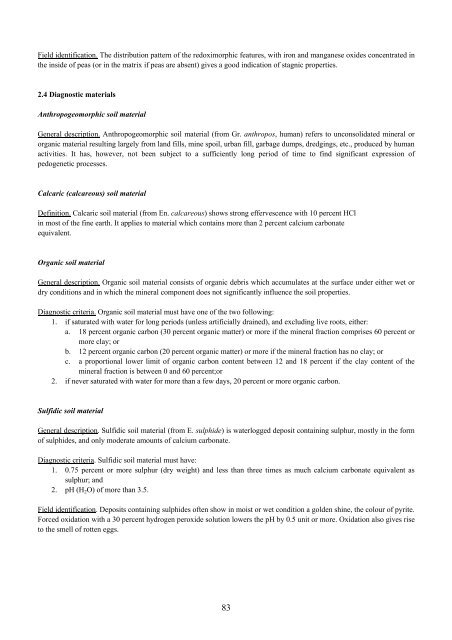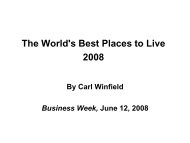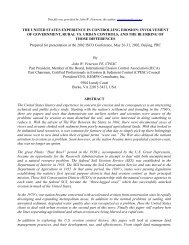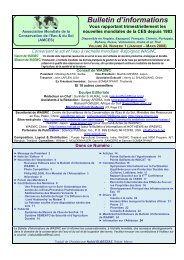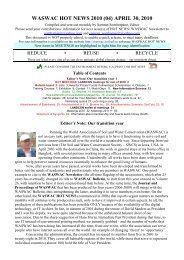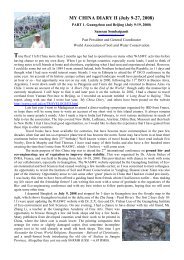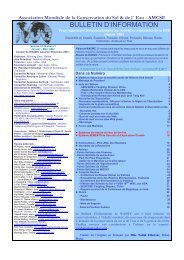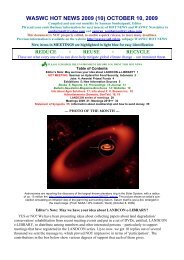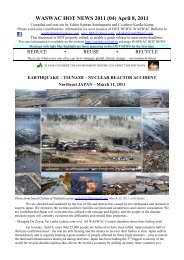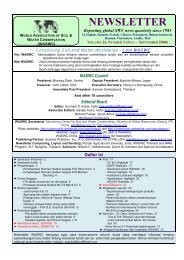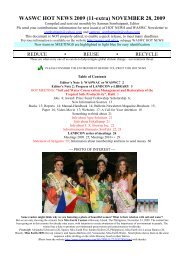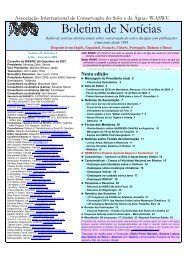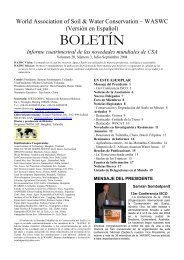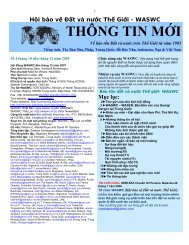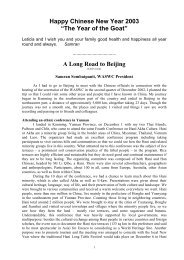a. in more than 50 percent <strong>of</strong> <strong>the</strong> soil mass; orb. in 100 percent <strong>of</strong> <strong>the</strong> soil mass below any surface horizon.Field identification. Iron and manganese (hydr)oxides in soils with gleyic properties are redistributed to <strong>the</strong> outside <strong>of</strong> <strong>the</strong>peas and towards <strong>the</strong> soil surface from where oxygen is derived. The resulting colour pattern (reddish, brownish oryellowish colours near <strong>the</strong> ped surface or in <strong>the</strong> upper part <strong>of</strong> <strong>the</strong> pr<strong>of</strong>ile, toge<strong>the</strong>r with grayish/bluish colours in <strong>the</strong> inside<strong>of</strong> <strong>the</strong> peas or deeper in <strong>the</strong> soil) indicates if gleyic conditions occur. Also, <strong>the</strong> dipyridyl test <strong>of</strong>ten gives a good indication ifferric iron is present in <strong>the</strong> soil solution.PermafrostDefinition. Permafrost is a layer in which <strong>the</strong> temperature is perennially at or below 0°C for at least two consecutive years.Secondary carbonatesGeneral description. The term secondary carbonates refers to translocated lime, s<strong>of</strong>t enough to be cut readily with a fingernail, precipitated in place from <strong>the</strong> soil solution ra<strong>the</strong>r than inherited from a soil parent material. As a diagnostic property itshould be present in significant quantities.Field identification. Secondary carbonates must have some relation to <strong>the</strong> soil structure or fabric. Secondary carbonateaccumulations may disrupt <strong>the</strong> fabric to form spheroidal aggregates or 'white eyes', that are s<strong>of</strong>t and powdery when dry, orlime may be present as s<strong>of</strong>t coatings in pores or on structural faces. If present as coatings, secondary carbonates cover 50percent or more <strong>of</strong> <strong>the</strong> structural faces and are thick enough to be visible when moist. If present as s<strong>of</strong>t nodules, <strong>the</strong>yoccupy 5 percent or more <strong>of</strong> <strong>the</strong> soil volume. Filaments (pseudomycelia), which come and go with changing moistureconditions, are not included in <strong>the</strong> definition <strong>of</strong> secondary carbonates.Stagnic propertiesGeneral description. <strong>Soil</strong> material has stagnic properties (from L. stagnare, to flood) if it is, at least temporarily, completelysaturated with surface water, unless drained, for a period long enough to allow reducing conditions to occur (this may rangefrom a few days in <strong>the</strong> tropics to a few weeks in o<strong>the</strong>r areas), and show a stagnic colour pattern 14 .Diagnostic criteria. Reducing conditions are evident by:1. a value <strong>of</strong> rH in <strong>the</strong> soil solution <strong>of</strong> 19 or less; or2. <strong>the</strong> presence <strong>of</strong> free Fe2 + as shown by <strong>the</strong> appearance <strong>of</strong> ei<strong>the</strong>r:a. a solid dark blue colour on a freshly broken surface <strong>of</strong> a field-wet soil sample, after spraying it with a 1%potassium ferric cyanide (K 3 Fe(III)(CN) 6 ) solution; orb. a strong red colour on a freshly broken surface <strong>of</strong> a field-wet soil sample after spraying it with a 0.2% a,a,dipyridyl solution in 10% acetic acid; and3. an albic horizon or a stagnic colour pattern ei<strong>the</strong>r:a. in more than 50 percent <strong>of</strong> <strong>the</strong> soil volume if <strong>the</strong> soil is undisturbed; orb. in 100 percent <strong>of</strong> <strong>the</strong> soil volume if <strong>the</strong> surface horizon is disturbed by ploughing.prevail due to iron sulphides. In calcareous material whitish colours are dominant due to calcite and/or siderite. Sands areusually light grey to white in colour and <strong>of</strong>ten also impoverished in iron and manganese. The upper part <strong>of</strong> areductomorphic horizon may show up to 5 percent rusty colours mainly around channels <strong>of</strong> burrowing animals or plantroots.14 A stagnic colour pattern shows mottling in such a way that <strong>the</strong> surfaces <strong>of</strong> <strong>the</strong> peas (or part <strong>of</strong> <strong>the</strong> soil matrix) are lighter(one Munsell value unit or more) and paler (one chrome unit or less) coloured, and <strong>the</strong> interior <strong>of</strong> <strong>the</strong> peas (or parts <strong>of</strong> <strong>the</strong>soil matrix) are more reddish (one hue unit or more) and brighter (one chrome unit or more) coloured than <strong>the</strong> nonredoximorphicparts <strong>of</strong> <strong>the</strong> layer, or <strong>of</strong> its mixed average. This mottling pattern may occur directly below <strong>the</strong> surfacehorizon or plough layer, or below an albic horizon.82
Field identification. The distribution pattern <strong>of</strong> <strong>the</strong> redoximorphic features, with iron and manganese oxides concentrated in<strong>the</strong> inside <strong>of</strong> peas (or in <strong>the</strong> matrix if peas are absent) gives a good indication <strong>of</strong> stagnic properties.2.4 Diagnostic materialsAnthropogeomorphic soil materialGeneral description. Anthropogeomorphic soil material (from Gr. anthropos, human) refers to unconsolidated mineral ororganic material resulting largely from land fills, mine spoil, urban fill, garbage dumps, dredgings, etc., produced by humanactivities. It has, however, not been subject to a sufficiently long period <strong>of</strong> time to find significant expression <strong>of</strong>pedogenetic processes.Calcaric (calcareous) soil materialDefinition. Calcaric soil material (from En. calcareous) shows strong effervescence with 10 percent HClin most <strong>of</strong> <strong>the</strong> fine earth. It applies to material which contains more than 2 percent calcium carbonateequivalent.Organic soil materialGeneral description. Organic soil material consists <strong>of</strong> organic debris which accumulates at <strong>the</strong> surface under ei<strong>the</strong>r wet ordry conditions and in which <strong>the</strong> mineral component does not significantly influence <strong>the</strong> soil properties.Diagnostic criteria. Organic soil material must have one <strong>of</strong> <strong>the</strong> two following:1. if saturated with water for long periods (unless artificially drained), and excluding live roots, ei<strong>the</strong>r:a. 18 percent organic carbon (30 percent organic matter) or more if <strong>the</strong> mineral fraction comprises 60 percent ormore clay; orb. 12 percent organic carbon (20 percent organic matter) or more if <strong>the</strong> mineral fraction has no clay; orc. a proportional lower limit <strong>of</strong> organic carbon content between 12 and 18 percent if <strong>the</strong> clay content <strong>of</strong> <strong>the</strong>mineral fraction is between 0 and 60 percent;or2. if never saturated with water for more than a few days, 20 percent or more organic carbon.Sulfidic soil materialGeneral description. Sulfidic soil material (from E. sulphide) is waterlogged deposit containing sulphur, mostly in <strong>the</strong> form<strong>of</strong> sulphides, and only moderate amounts <strong>of</strong> calcium carbonate.Diagnostic criteria. Sulfidic soil material must have:1. 0.75 percent or more sulphur (dry weight) and less than three times as much calcium carbonate equivalent assulphur; and2. pH (H 2 O) <strong>of</strong> more than 3.5.Field identification. Deposits containing sulphides <strong>of</strong>ten show in moist or wet condition a golden shine, <strong>the</strong> colour <strong>of</strong> pyrite.Forced oxidation with a 30 percent hydrogen peroxide solution lowers <strong>the</strong> pH by 0.5 unit or more. Oxidation also gives riseto <strong>the</strong> smell <strong>of</strong> rotten eggs.83


